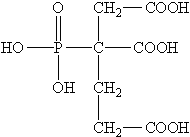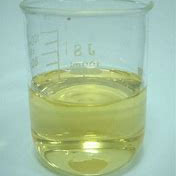2-Phosphonobutane -1,2,4-Tricarboxylic Acid
NANJING FINECHEM HOLDING CO., LTD
General Information
Chemical & Physical Properties
Safety Information
Synthetic Route
| Common Names |
2-Phosphonobutane-1,2,4-tricarboxylic acid|3-Carboxy-3-phosphonohexanedioic acid
|
| Structure |
 |
| CAS No. |
37971-36-1 |
Boiling Point (℃) |
545.2ºC at 760 mmHg |
| Molecular Weight |
270.13100 |
Melting Point (℃) |
N/A |
| Appearance |
Colorless or light yellow transparent liquid |
Vapor Specific Gravity |
1.275 |
| HS Code |
2931900090 |
Flash Point (℃) |
283.5ºC |
| Solubility |
Miscible with water in any proportion |
Autoignition Temperature (℃) |
N/A |
| Safety Phrases |
S26-S45 |
| RIDADR |
UN 3265 |
| WGK Germany |
N/A |
| Packaging Group |
III |
| Hazard Class |
8 |
|
SYMPTOMS |
PREVENTION |
FIRST AID |
| Inhalation |
Cough. Sore throat. |
Use local exhaust or breathing protection. |
Fresh air, rest. |
| Skin |
Redness. Burning sensation. Itching. |
Protective gloves. |
Remove contaminated clothes. Rinse and then wash skin with water and soap. |
| Eyes |
Redness. Pain. |
Wear safety goggles. |
First rinse with plenty of water for several minutes (remove contact lenses if easily
possible), then refer for medical attention. |
| Ingestion |
Abdominal pain. Nausea. Vomiting. |
Do not eat, drink, or smoke during work. Wash hands before eating. |
Rinse mouth. Induce vomiting (ONLY IN CONSCIOUS PERSONS!). Refer for medical attention. |
1.Phosphorus oxychloride is added dropwise to a solution of maleic anhydride in chloroform, while
stirring under nitrogen atmosphere. The reaction mixture is then refluxed for several hours, leading to
the formation of MAPC.
2.The MAPC intermediate is then treated with phosphonoacetic acid in the presence of a base such as
triethylamine or sodium hydroxide. The reaction mixture is stirred at elevated temperatures, typically
between 80-100°C, until the PTCA product is formed.
3.The PTCA product is then purified by methods such as recrystallization or chromatography to obtain a
high purity product.
Frequently Asked Questions
The stability of 2-Phosphonobutane-1,2,4-tricarboxylic acid?
This product is resistant to acid, alkali and oxidant. It can be miscible with water in any proportion,
and the pH of 1% aqueous solution is 1, and it has good thermal stability. It is stable to hydrolysis,
no hydrolysis is found in water up to 120°C, and it has good corrosion and scale inhibition performance.
Tolerates chlorine gas or chlorine products and ferric ions in water better than other phosphonates. It
has good compatibility with commonly used water treatment agents and has a synergistic effect.
The storage condition of this product?
This product needs to be packed in plastic barrels with a net weight of 35kg and lined with polyethylene
for storage for more than 2 years. If the temperature is too low to solidify, there will be no adverse
effects after thawing or continuing to use. Since this product has a certain corrosive effect on
materials, the containers, pumps and pipelines should be made of stainless steel, glass and
plastic.
What is 2-Phosphonobutane-1,2,4-tricarboxylic acid(PBTCA) used for?
This product is a good corrosion and scale inhibitor, widely used in anti-scaling treatment of
circulating cooling water system and oilfield water injection system.
It is used as a corrosion and scale inhibitor for industrial water treatment. This product has excellent
complexing ability with Ca2+, Zn2+, Cu2+, Mg2+ plasma. Suitable for use within the pH range of 7.0-9.5.
It can operate under the conditions of high temperature, high hardness and high alkalinity. It can
increase the concentration factor of circulating cooling water to more than 7.





